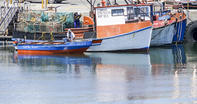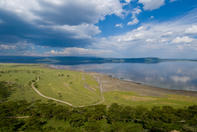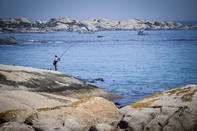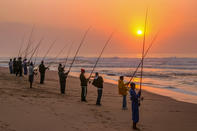Continental Drift, Wind and Currents
The Benguela Current is a cold body of water which moves up the western coastline of southern Africa and brings with it one of the richest fisheries in the world.

How it came to be this way is intricate and complex, a delicate interplay of continental drift, wind patterns, and cold ocean currents. It happens something like this: because of the way Earth’s landmasses are configured at the moment and the way the planet’s spin and convection processes churn up the ocean’s waters, some very deliberate actions play themselves out in the world’s currents, determining where the big fishing grounds are found.
Hot and Cold

First, warm air rising over the equator and sinking at the poles creates perpetual cycles of air, in distinctive “cells”, which help redistribute heat through the system and stir the oceans into motion.
As the Earth pirouettes around its axis, on its journey through space, that spin creates forces which also exert themselves on the movement of air and ocean. In the Southern Hemisphere, this deflects surface currents to the left as they near the equator, and in the Northern Hemisphere it deflects to the right.
The overall result is that each large body of ocean develops an anti-clockwise spin if it is south of the equator, or a clockwise spin if it is north of the equator. As these tremendous “gyres” move alongside the equator, they pick up heat which they carry with them and later deliver along whatever coastline they touch on their “western boundary”.
Then they sweep closer to the poles, where they are leached of much remaining heat. Once these waters have been chilled, they continue on their cycle back towards the equator but will deliver cold currents to the “eastern” side of each ocean.
One Ecosystem

The Benguela Current is one of four “eastern boundary current systems” globally, one which scientists think of as one ecosystem which starts just east of Port Elizabeth, sweeps past Cape Town, up the West Coast, past Namibia and all the way to Cabinda in the very north of Angola.
It is not contained within any national boundary, but its resources are nevertheless shared across three countries and its character shaped by processes happening in oceans very far from here. It was born when Antarctica finally floated free of the South American continent about 25 million years ago, allowing the Southern Ocean to move in an uninterrupted path around the Southern Hemisphere.
The Benguela was one of the many currents to spin-off from this huge body of circling water, where it still heads inexorably north, along South Africa’s West Coast, its cool temperature scouring the air of moisture and seeding Namibia’s desert.
Ocean Pastures

The prevailing south-easterly winds of the Cape’s summer blow the Atlantic’s surface water, which has been warmed by the sun, away from the coastline, forcing cooler water from the ocean’s depths to take its place. This “upwelling” brings with it the accumulated nutrients from the sea floor – decomposing seaweed, dead animals, faeces, and anything else that might have floated down to become part of the marine compost heap.
The cold, nutrient-loaded water rushes to the surface where, bathed in sunlight, it provides food for massive blooms of marine algae. These are the ocean’s pastures. Zooplankton – microscopic plant-eating marine animals – then graze the algae; fish eat the plankton; birds, sharks and mammals eat the fish. It’s an entire food chain that is driven by the washing machine action of ocean current and wind and it brings food to the hooks of the fishermen.
Teaming shoals of sardine, hake, anchovy, horse mackerel, tuna and snoek extend their reach across this ethereal ribbon of ever restless water and they are the mainstay of the bulk fishing industry. In the south, the endemic West Coast rock lobster picks across the seafloor while in the far north, shrimp and deep sea crab abound.
By Leonie Joubert